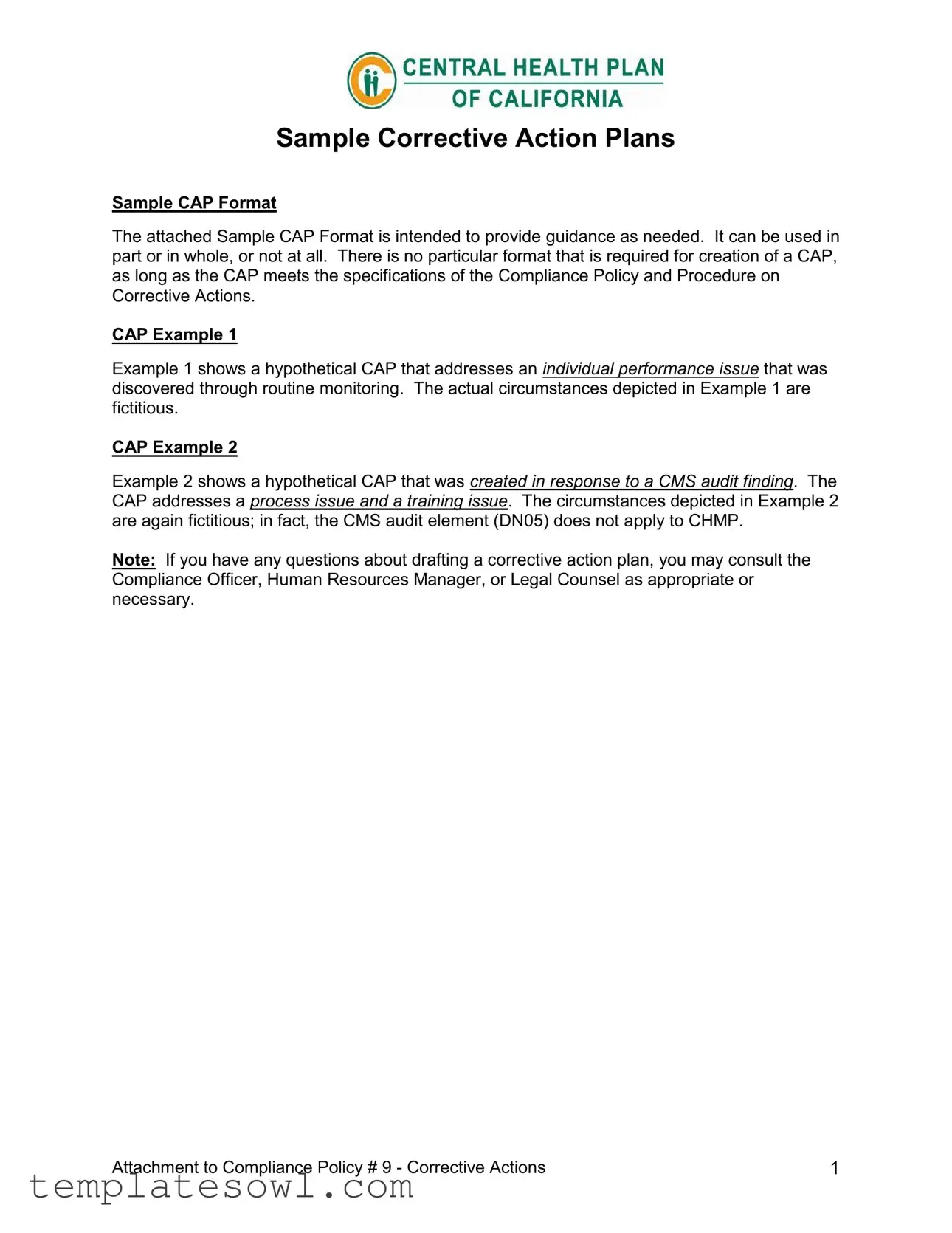Sample Corrective Action Plans
Sample CAP Format
The attached Sample CAP Format is intended to provide guidance as needed. It can be used in part or in whole, or not at all. There is no particular format that is required for creation of a CAP, as long as the CAP meets the specifications of the Compliance Policy and Procedure on Corrective Actions.
CAP Example 1
Example 1 shows a hypothetical CAP that addresses an individual performance issue that was discovered through routine monitoring. The actual circumstances depicted in Example 1 are fictitious.
CAP Example 2
Example 2 shows a hypothetical CAP that was created in response to a CMS audit finding. The CAP addresses a process issue and a training issue. The circumstances depicted in Example 2 are again fictitious; in fact, the CMS audit element (DN05) does not apply to CHMP.
Note: If you have any questions about drafting a corrective action plan, you may consult the Compliance Officer, Human Resources Manager, or Legal Counsel as appropriate or necessary.
Attachment to Compliance Policy # 9 - Corrective Actions |
1 |
SAMPLE FORMAT
CORRECTIVE ACTION PLAN
I.ISSUE / PROBLEM DEFINITION (Be specific – quantify if possible)
II.ROOT CAUSE EVALUATION
III.ACTION STEPS
IV. IMPROVEMENT BENCHMARK(S) AND TIMEFRAME
V.CERTIFICATION
The undersigned have read this Corrective Action Plan and agree to its terms.
Date
Date
Date
Attachment to Compliance Policy # 9 - Corrective Actions |
2 |
EXAMPLE 1
CORRECTIVE ACTION PLAN
I.ISSUE / PROBLEM DEFINITION (Be specific – quantify if possible)
The cancellation rate and rapid disenrollment rate for applications submitted by John Doe have increased significantly in recent months. Prior to February, John’s cancellation and rapid disenrollment rates compared favorably with team averages. However, since February 1, his cancellation rate has been 7% to 11% over average, and his rapid disenrollment rate has been 9% to 11% over average.
II.ROOT CAUSE EVALUATION
According to the Cancellation and Disenrollment Logs, the most common cancellation or rapid disenrollment reasons given by John’s enrollees were:
They were seeing a specialist who was not available with CHMP
They could not get the PCP they wanted
They were confused or unaware of how to obtain a referral for specialist care
Sales records indicate that John’s gross sales production has shown a sharp increase
commensurate with the increase in cancellations and rapid disenrollments. Prior to February 1, John’s gross production was typically within 5% of the team average. Since February 1, his
gross production has exceeded the team average by 13% to 18%. John has stated that he began a major push in February to increase sales, and that he has been more focused on obtaining enrollments during his appointments.
Conclusion: In John’s efforts to increase production, he has unintentionally sacrificed quality,
particularly in the wrap-up phase of his appointments. Therefore, some of his enrollees do not fully understand the basics of provider selection and specialist referrals.
III.ACTION STEPS
John Doe will:
1.Slow down at the end of the presentation and exercise more care to assure that enrollees understand:
How to select a PCP, whether their current PCP is a CHMP provider, etc.
How to obtain a referral for specialist care
Whether their specialist(s) will still be available as a CHMP member, and if so, that they will still need a referral
2.Prepare a list of probing questions that can be used during presentations to clarify these issues. Seek input from Manager if desired. Present the list to Manager for review by June 5, 2008, and role play presentation scenarios with Manager.
3.Schedule a weekly meeting with Manager to review performance. Continue weekly meetings for the duration of this action plan or until cancellation and rapid disenrollment rates are satisfactory, whichever is first.
Attachment to Compliance Policy # 9 - Corrective Actions |
3 |

Sales Manager will:
1.Review list of probing questions with John and role play presentation scenarios.
2.Schedule at least three joint sales appointments with John, on different days, between June
5 and June 30. Observe John’s presentation and provide detailed feedback.
3.By June 30, perform random phone interviews with five different beneficiaries John has enrolled between June 5 and June 30 to assess their experiences with John.
4.Based on results of the joint sales appointments and random phone interviews, determine if these activities should be repeated in July, and if necessary, August.
5.Starting the week of June 9, review the Cancellation Log at least once per week to track John’s performance. Continue weekly review for the duration of this action plan, or until cancellation and rapid disenrollment rates are satisfactory, whichever is first.
6.Starting the week of July 7, review the Disenrollment Log at least once per week to track rapid disenrollment rate for enrollments John submits AFTER June 5. Continue weekly review for the duration of this action plan, or until cancellation and rapid disenrollment rates are satisfactory, whichever is first.
7.Schedule weekly meetings with John to provide feedback and additional training as appropriate. Continue weekly meetings for the duration of this action plan, or until cancellation and rapid disenrollment rates are satisfactory, whichever is first.
IV. IMPROVEMENT BENCHMARK(S) AND TIMEFRAME
1.John’s cancellation rate must drop to 8% or lower for the month of June, and 6% or lower for the months of July and August. Manager will continue to monitor thereafter.
2.John’s rapid disenrollment rate must drop to 10% or lower for the months of August and
September. Manager will continue to monitor thereafter.
Failure to achieve these improvement benchmarks could result in additional corrective action.
This Corrective Action Plan is effective 6/1/2008 through 9/30/2008.
V.CERTIFICATION
The undersigned have read this Corrective Action Plan and agree to its terms.
John Doe, Sales Representative |
Date |
Jack Black, Sales Manager |
Date |
Attachment to Compliance Policy # 9 - Corrective Actions |
4 |
EXAMPLE 2
CORRECTIVE ACTION PLAN
I.ISSUE / PROBLEM DEFINITION (Be specific – quantify if possible)
During the recent CMS monitoring visit (April 7 – April 10), the reviewers determined that the organization did not meet the standards for Element DN05 – Involuntary Disenrollment for Non- Payment of Premiums. According to the Audit Report (received May 19), CMS identified the following specific issues:
The Plan did not consistently apply the grace period before issuing final notice of non- payment (6 of 20 cases)
The final notice of non-payment was not timely (9 of 20 cases)
The requirements that govern Element DN05 are found at 42 C.F.R. § 422.74(d)(1), and the Managed Care Manual, Ch. 2 – Section 50.3.1.
II.ROOT CAUSE EVALUATION
The CMS Audit Report states: “The Plan did not demonstrate a clear process or procedure for handling non-payment issues. The Plan’s written policy stated only that ‘Notifications and disenrollments for non-payment of premium will be processed according to CMS requirements.’
However, staff members seemed unclear about the CMS requirements governing non-payment.
The Plan utilized appropriate CMS model notices. The timeliness issue for the final notice apparently resulted from incorrect understanding and calculation of the grace period.”
Management analysis confirms that the CMS evaluation is essentially correct. The organization lacks a clearly defined procedure for processing non-payment issues. Further, staff members have not been adequately trained regarding applicable CMS requirements.
III.ACTION STEPS
The CMS Audit Report states: “The Plan must develop a complete policy and procedure that
sufficiently addresses all regulatory requirements for involuntary disenrollments due to non-
payment of premium. Further, the Plan must ensure that staff members responsible for the process are adequately trained to understand the regulatory requirements and follow the Plan’s procedure.”
The Department Manager will:
1.Develop a Policy and Procedure that meets all applicable requirements and establishes a consistent, compliant process for non-payment disenrollments.
Initial draft to be completed by May 30, 2008, and forwarded to the Department Director and Compliance Department for review.
Final Policy and Procedure approved and effective by June 9, 2008.
2.Develop a short training module and single-page reference table explaining CMS requirements for non-payment disenrollments. Deliver the training and distribute the reference table at department staff meeting May 27.
3.Distribute new Policy and Procedure at June 10 staff meeting, and review in detail. Review CMS requirements and discuss how the new P & P meets those requirements.
Attachment to Compliance Policy # 9 - Corrective Actions |
5 |

4.Monitor 100% of involuntary disenrollment cases due to non-payment of premium from June 16 through August 30 to assess performance.
5.Provide feedback on performance under the new P & P, and review training as appropriate, at all bi-weekly staff meetings through August 30, and into September if necessary.
IV. IMPROVEMENT BENCHMARK(S) AND TIMEFRAME
Based on review of 100% of involuntary disenrollment cases due to non-payment of premium:
1.At least 80% of cases should be in compliance for the month of July, 2008
2.The required level of at least 95% compliance should be achieved for the months of August and September, 2008.
The Department Manager will continue with monitoring program thereafter sufficient to measure ongoing compliance.
Failure to achieve these improvement benchmarks could result in additional corrective action.
This Corrective Action Plan is effective 5/26/2008 through 9/30/2008.
V.CERTIFICATION
The undersigned have read this Corrective Action Plan and agree to its terms.
JOAN J. JETT
Joan Jett, Department Manager
Betty Boop
Betty Boop, Department Director
Maggie Thatcher
Margaret Thatcher, Compliance Officer
May 25, 2008
Date
May 26, 2008
Date
May 26, 2008
Date
Attachment to Compliance Policy # 9 - Corrective Actions |
6 |





